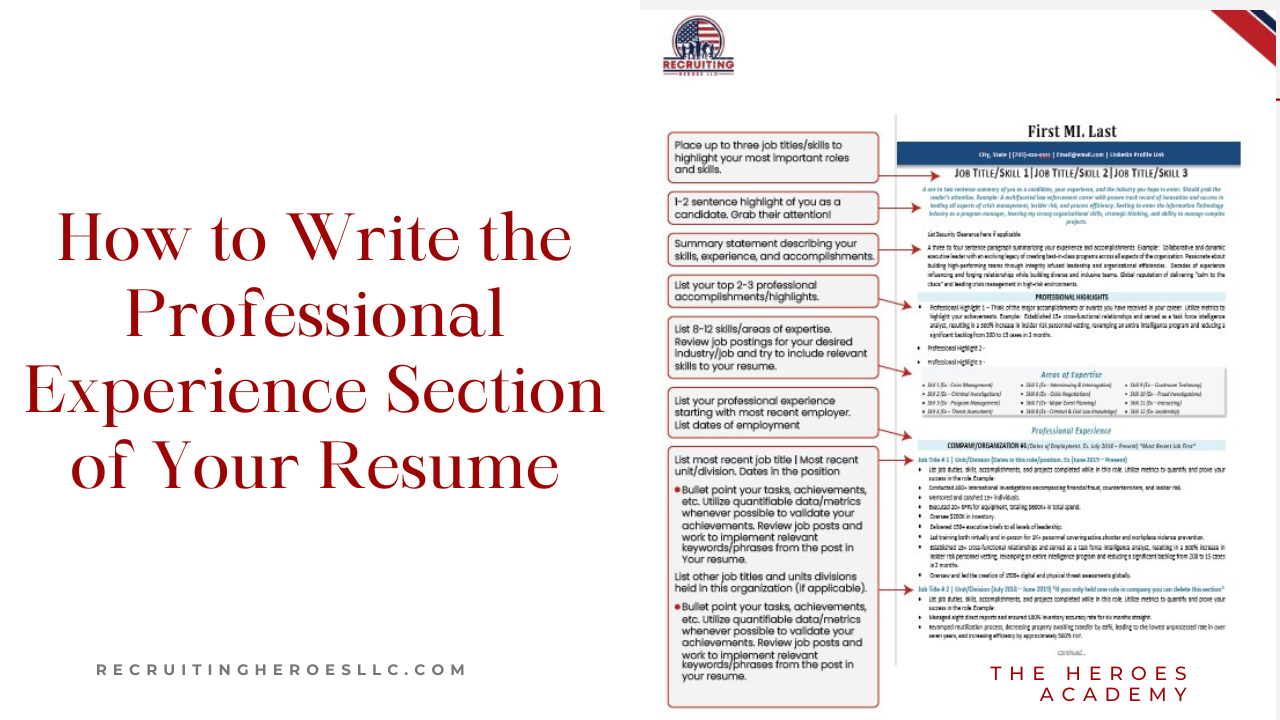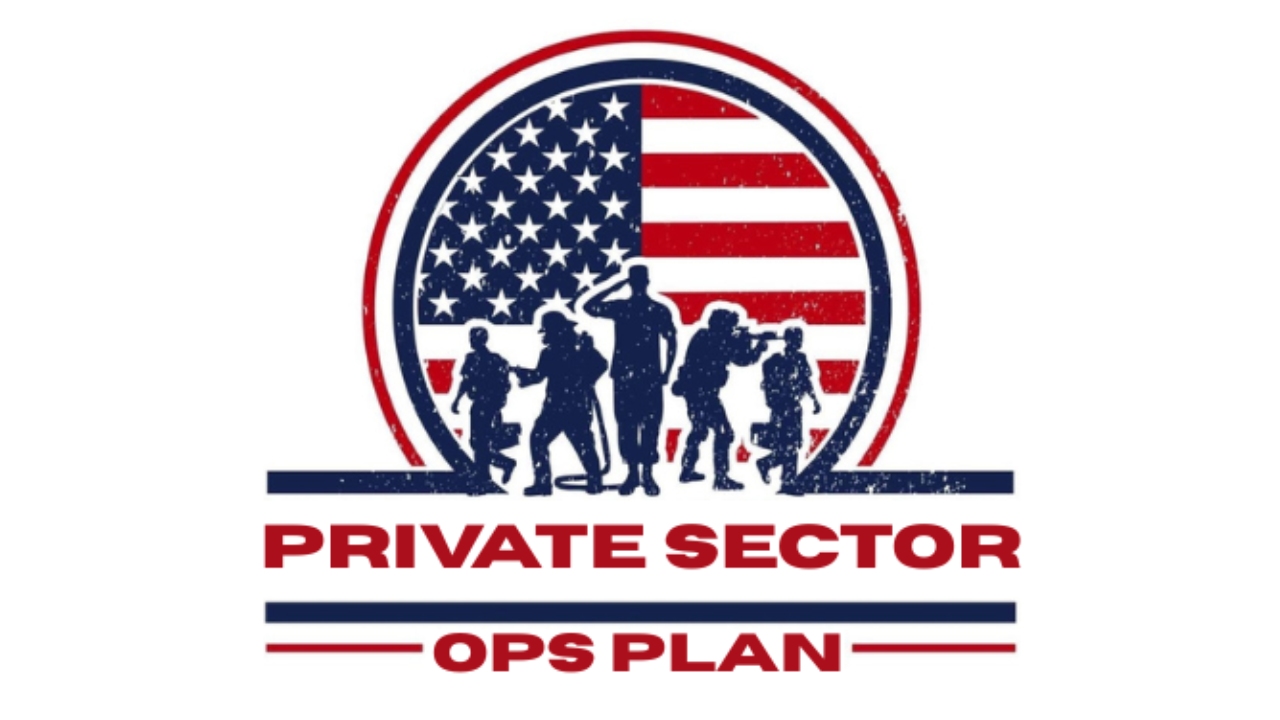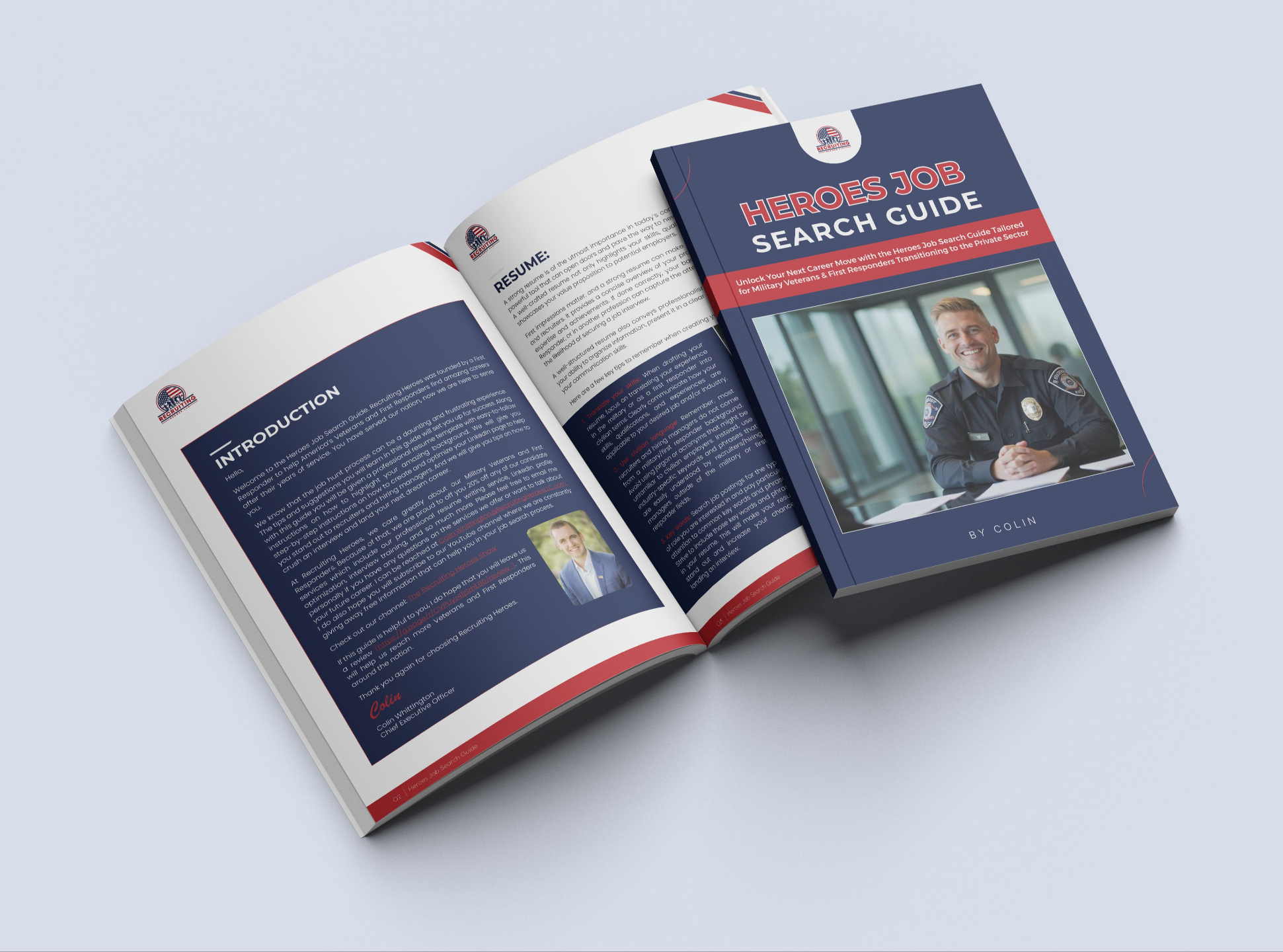Writing a Powerful Professional Experience Section of Resume: A Sneak Peek Inside The Heroes Academy
Nov 06, 2025
This article is a sneak peek into one of the lessons from The Heroes Academy, my flagship career transition program designed to help law enforcement officers successfully move from a life of service into the private sector.
Inside the Academy, members get access to the same strategies I’ve used to help more than 700 law enforcement professionals land meaningful, high-paying careers across 15+ different industries. Each lesson includes an in-depth video training where I personally guide you through a specific part of the job search process. You’ll also receive detailed workbooks, templates, and step-by-step resources to make everything clear and actionable.
The lesson I’m sharing with you today focuses on how to write the Professional Experience section of your resume, one of the most critical parts of the entire document. You’ll learn how to turn your career story into a results-driven narrative that highlights your achievements, shows measurable impact, and positions you as a standout candidate for your next role.
If you’ve ever struggled to describe your experience in a way that truly reflects your value, or if your resume feels like it undersells your accomplishments, this guide will change that. The Resume Writing module inside The Heroes Academy breaks down every part of the process so you can confidently create a professional, polished resume that commands attention.
You can learn more and enroll here: Heroes Academy | Career Transition Course for Law Enforcement Officers
But for now… let’s dive in.
Watch the video training for this lesson here: https://youtu.be/CKjtfmQL5zM

Why the Professional Experience Section Matters So Much
When a recruiter opens your resume, this is where their eyes naturally go first. They’re scanning for one thing: impact.
They want to know not only what you’ve done but why it matters. How did your work make a difference? What tangible results did you achieve? What leadership, decision-making, or analytical abilities did you demonstrate that could translate into value for their organization?
Your Professional Experience section tells the story of your career... where you’ve been, what challenges you’ve faced, and how you’ve created results. It’s not just a list of job duties. It’s a showcase of your effectiveness, your problem-solving ability, and your professional evolution.
When written effectively, this section does more than summarize your past, it proves your future potential.
What Is the Professional Experience Section?
The Professional Experience section is a reverse-chronological record of your work history. You’ll start with your most recent position and work backward, usually covering the last 10–15 years of your career.
Each entry should include:
- Job title
- Company or agency name
- Location
- Dates of employment
- Accomplishment-based bullet points highlighting achievements
Here’s the key: this section isn’t about tasks, it’s about results. Anyone can list responsibilities. What sets you apart is demonstrating the impact you made in each role.
For example, writing “Responded to emergency calls” doesn’t show what makes you different from the next officer. But saying “Responded to and resolved over 1,200 emergency calls annually, maintaining a 98% response compliance rate and enhancing community safety through proactive engagement” tells a much stronger story.
That one line shows scope, results, and initiative, all qualities hiring managers love.
How to Write an Effective Professional Experience Section
Inside the Heroes Academy, members receive a fantastic guide called the Experience Worksheet. This document is a tool that guides you through brainstorming and structuring your experience effectively. Inside The Heroes Academy, we go step-by-step through this process, but here’s the full framework you can start using today.
Step 1: Start With the Basics
Each entry in your Professional Experience section should begin with a clean, consistent format.
Example: Huntsville Police Department – Huntsville, AL | Jan 2020 – Present Fraud Investigator
Consistency matters. Use the same format for each position. Recruiters spend only a few seconds scanning your resume (7.4 seconds on average... to be exact!), and neat formatting helps them quickly grasp your career trajectory.
Step 2: Use Bullet Points to Highlight Achievements
This is where you bring your work to life. Each bullet point should follow the CAR method: Challenge, Action, Result.
Challenge:
What problem, situation, or task did you face?
Action:
What steps did you take to address it?
Result:
What measurable impact did you achieve?
Here are a few examples of what that looks like in practice:
• Led over 15 fraud investigations, resolving cases within four weeks and securing full restitution for affected victims through efficient evidence collection and collaboration with prosecutors.
• Partnered with the Glen Carbon Police Department on metro-wide theft investigations, resulting in the apprehension of multiple felony suspects and a significant reduction in regional theft incidents.
• Developed and implemented new fraud prevention protocols that reduced financial losses by 20%, enhancing agency efficiency and public trust.
• Mentored and trained newly assigned investigators, increasing team performance and case resolution rates by 30% through targeted development programs.
Each bullet tells a small story. It identifies a challenge, explains your actions, and ends with results that show measurable impact.
Step 3: Quantify Achievements Wherever Possible
Metrics are one of the strongest storytelling tools in a resume. They provide context and credibility.
If you’re not sure what numbers to include, think about:
- How many cases you investigated, managed, or solved
- How much time or money you saved your organization
- How many people you led or trained
- How frequently you performed key tasks
Even rough estimates are better than none.
Example Transformations:
- ❌ Conducted investigations into fraudulent activities ✅ Investigated 25+ fraud cases annually, recovering over $500K in assets and ensuring successful prosecution of offenders
- ❌ Responsible for training new staff ✅ Trained and mentored 8 new investigators, improving department efficiency by 30% and reducing onboarding time by two weeks
Numbers jump off the page. They create instant credibility and make your accomplishments tangible.
Step 4: Use Strong Action Verbs
Every bullet point should start with a strong, active verb that conveys initiative and leadership. Avoid passive or vague phrases like “responsible for” or “helped with.”
Here’s a quick list of verbs that make your achievements stand out:
- Led
- Analyzed
- Coordinated
- Implemented
- Designed
- Investigated
- Developed
- Directed
- Improved
- Negotiated
- Oversaw
- Streamlined
Example: Weak: Responsible for reviewing fraud reports Strong: Analyzed and processed over 50 fraud reports monthly, identifying emerging trends that reduced financial loss by 25%
That one change transforms the statement from generic to impressive.
Step 5: Show Career Growth
Hiring managers love to see progression. It signals dedication, learning, and leadership potential. If you’ve been promoted or taken on more responsibility, make it clear.
Example: Promoted from Patrol Officer to Fraud Investigator within two years, recognizing outstanding investigative performance and leadership ability.
You can even highlight increases in scope or scale, such as managing more cases, overseeing larger teams, or implementing new systems.
Step 6: Tailor Your Experience for Each Job
One of the biggest mistakes candidates make is using the same resume for every application.
Every organization has its own priorities. The language they use in their job postings gives clues about what they value most. Align your resume with that language.
For example, if a corporate security role emphasizes “risk assessment” and “incident response,” highlight your related experience with threat management and emergency operations.
Inside The Heroes Academy, we show members exactly how to deconstruct a job posting and mirror its key terms in their resume to increase their chances of passing through Applicant Tracking Systems (ATS).
Example of a Well-Written Professional Experience Section
Here’s what it all looks like when it comes together:
Huntsville Police Department | Huntsville, AL | Jan 2020 – Present Fraud Investigator
- Led 15+ fraud investigations, ensuring restitution within four weeks and securing successful prosecutions
- Analyzed financial records and digital evidence, uncovering fraudulent transactions worth over $500K
- Partnered with cross-agency teams, increasing resolution rates by 30%
- Developed cybersecurity protocols that reduced data breaches by 40%
Marana Police Department | Marana, AZ | Jan 2014 – Dec 2019 Patrol Officer
- Conducted 1,500+ proactive patrols, contributing to a 15% reduction in community crime rates
- Responded to critical incidents, applying crisis intervention tactics to de-escalate volatile situations
- Mentored new recruits in investigative procedures, strengthening departmental readiness
- Led tactical response operations, improving team safety and performance by 25%
Heroes Tips for Crafting a Winning Professional Experience Section
- Stick to standard job titles – Use recognizable terms like “Detective,” “Sergeant,” or “Investigator” rather than internal codes or abbreviations like “FTO.”
- Keep it scannable – Use bullet points, not long paragraphs. Hiring managers spend less than 10 seconds on an initial review.
- Avoid jargon – Simplify your language. Terms familiar in law enforcement may not translate to the private sector.
- Focus on recent roles – Highlight your last 10–15 years. Older positions can go in an “Additional Experience” section.
- Tailor every resume – Match your achievements and keywords to the position you’re applying for.
Your Turn: Build Your Professional Experience Section
Now it’s your turn to apply what you’ve learned. Download the Professional Experience Builder Workbook (included in this lesson inside The Heroes Academy) or use a blank piece of paper until you have the chance to enroll in this fantastic program!
This guided worksheet walks you step-by-step through:
- Capturing your job snapshot – Enter your job title, agency or company, location, and dates of employment.
- Brainstorming bullet points using the CAR method – Identify challenges you faced, actions you took, and results you achieved.
- Choosing strong action verbs – Replace weak language like “responsible for” with verbs like “led,” “implemented,” and “enhanced.”
- Adding metrics – Use quantification prompts to identify where you can include data that shows measurable results.
- Reviewing a completed example – Model your entries after a polished, professional example to ensure consistency and clarity.
Once you complete your worksheet, you’ll have everything you need to build a compelling Professional Experience section for your resume, one that tells your story with clarity, confidence, and measurable impact.
Watch the Lesson
To see this process in action, watch the free sneak peek video from The Heroes Academy, where I walk you through real examples and teach you how to transform raw experience into powerful resume content.
You’ll learn how to:
- Identify transferable skills from your law enforcement or military background
- Use metrics and results to stand out from the competition
- Reframe your public service experience in a way that resonates with corporate recruiters
This video is pulled directly from one of our most popular lessons inside The Heroes Academy, so you’ll get a firsthand look at how members learn to write resumes that consistently get interviews.
Watch it here: https://youtu.be/CKjtfmQL5zM
What’s Next?
Once your Professional Experience section is strong and results-driven, the next module in The Heroes Academy will show you how to polish the remaining sections of your resume:
- Education – How to format degrees, certifications, and relevant coursework
- Certifications & Training – Which ones to include (and which to leave off)
- Awards & Commendations – How to position them as evidence of excellence
- Technical Skills – How to highlight software, systems, and digital tools that align with your target career
You’ll also learn how to write a professional summary that instantly captures attention, as well as how to tailor your resume for specific industries like cybersecurity, investigations, compliance, and operations management.
Final Thoughts
Writing about yourself isn’t easy, especially when you’ve spent your career focused on teamwork, service, and humility. But your resume isn’t about bragging; it’s about communicating your value.
Every bullet point you write is a chance to show a hiring manager the kind of professional you are, someone who leads, solves problems, and makes measurable impact.
This lesson from The Heroes Academy is designed to help you do exactly that.
If you found this helpful and want full access to the complete program, including templates, worksheets, private community support, and over a dozen video lessons covering every step of your job search, you can learn more about The Heroes Academy here: Heroes Academy | Career Transition Course for Law Enforcement Officers
You’ve already taken the first step by reading this. Now take the next one and start building the career you deserve.
Let’s get to work.
Looking for your next career? Learn how the Heroes Academy is the only transformational program designed specifically for law enforcement officers!
Have a Question For Us?
We'd Love to Hear From You!
We hate SPAM. We will never sell your information, for any reason.





